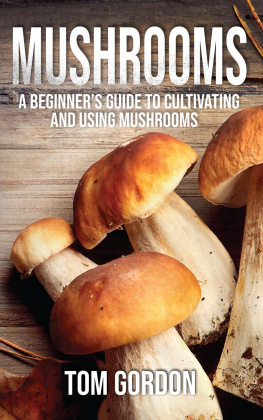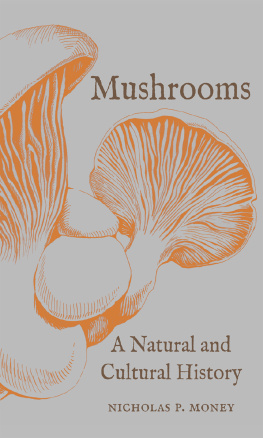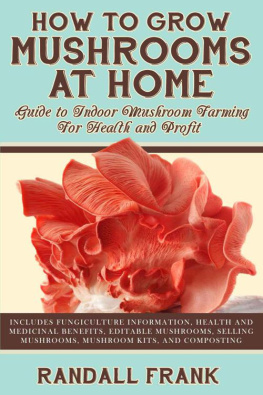Acknowledgments
My father was a mycologist by necessity: He had to find food when he was close to starvation in Eastern Galicia during his childhood, and in Siberia during the family exile of 1916. He taught me about the cpes, chanterelles, and trompettes-de-la-mort when we were hiding from the French police and the Gestapo in the Ardche in 1941, and around Aiguebelette in 1942. It was then I discovered the shapes, the colors, the taste, and the magic of marvelous and accessible foods. During the short breaks outside the refugee camps in Switzerland, I found myself hoping for rain during the late summer or early fall, and would crawl back to the hidden, secret circles where these delicious mushrooms would sprout, sending their odoriferous messages to be captured only by the initiated.
My next experience with mushrooms was my initiation to the medicinal properties of Psylocybes during my residency as a shrink; we did not jump, fly, or get sick. We just discovered a new world, shared with the curanderas and our schizophrenic patients. But Tomio Toda, the immunologist and Noh Master, was promoting Lentinula edodes, the shiitake mushroom, as an immunostimulant against our Corynebacterium parvum. Soon, Lentinan, the stimulant made from shiitake, would be a major drug in Japan.
My attraction to mushrooms was justified, and my quest would take me to the Pacific Rim: Asia and California. Here we are, and I must thank Norman Goldfind, my agent, for helping us with this volume; George de Kay, the publisher, is confident and will help for the success of this book. Peter Weverka provided his time, research, skills, humor, patience, and typing skills: he made this book. I cannot forget my wife and daughters, not because they escaped too often the fate of Sacha Guitrys own as described in the first pages of his Roman dun Tricheur, but simply because they still love me despite the long physical and mental absences.
Georges Halpern, M.D., Ph.D.
Portola Valley, California
January, 2002
On a brilliant, sunny Los Angeles morning in the summer of 1987, while on a business trip searching for new products and suppliers for my Chinese herbal products company, I found myself in a small herb shop in Venice Beach. Surrounded by large glass vessels of exotic-looking botanicals and shelves full of packaged tonics treasured for centuries as agents of radiant health, I found myself mesmerized by the oratory of the owner, who went on at length about the life-transforming qualities of a large red mushroom called reishi, known as the mushroom of immortality by the ancient Taoists and spiritual adepts of the Orient.
A spore was planted in my mind that day; it took root and germinated into a fifteen-year journey exploring the benefits, research, cultivation technologies, and art of medicinal mushrooms. It has been a fascinating time for me, and I have met many dedicated and wonderful people along the way. I would like to acknowledge their support and contributions here.
Special thanks goes to Dr. E. J. Wilson, Jr., who has been a loyal, kind, and great business partner for almost two decades and who has pioneered brilliant and novel technologies for preparing medicinal mushrooms for increased bioavailability, potency, and benefit for the consumer.
Thanks to Dr. Randy Dorian of Hanuman Medical and Dr. Moshe Shifrine for their support and collaboration on working toward the advancement of liquid culture medicinal mushroom cultivation. Their art will benefit many, many people as the value of medicinal mushrooms becomes more and more recognized. Thanks to Jordan Rubin for his wealth of knowledge, good cheer, and positive attitude. Of course, Dr. Georges Halpern, friend and colleague, who encouraged me to collaborate with him on this book and to share my experiences and knowledge to help further the cause. Thank you to Peter Weverka, friend and fellow carpooler, who was the glue that cemented the ideas and text of this book. Thanks to all those who helped along the way, and especially to Thomas Hickey, whose sudden passing has taken us by surprise. As president of Tea Garden Products, Inc., he brought a degree of professionalism and ethical conduct to our industry that was admired by many. I will miss his insightful comments and long conversations about medicinal mushrooms and Chinese herbs. Last but not least, to my wife, Martine, and daughters, Louise and Pauline, who have always been my strongest inspiration to be and do the best I can.
Andrew H. Miller
San Francisco, California
June, 2002
CHAPTER ONE
Introducing Medicinal Mushrooms
IN SEPTEMBER 1991, hikers in the Tyrolean Alps made a remarkable discovery. On a steep, rocky ridge at 10,500 feet above sea level, they found a 5,300-year-old mummy, the oldest intact human being ever discovered. The Iceman, as he came to be known, yielded much information about the neolithic period in which he lived. He carried a copper axe. Previous to the Icemans discovery, scientists believed that humans were smelting and shaping copper 4,000, not 5,300, years ago. Also, he may have undergone a treatment resembling acupuncture. The tattoos on his legs and back were on or near the acupuncture points for treating arthritis.
To mycologists, the botanists who study fungi, the most interesting aspect of the Iceman was his medicine kit. Strung to a leather thong, he carried, two walnut-sized dried fungi that researchers have identified as Piptoporus betulinus. The fungus is known for its antibiotic properties. When ingested, it can bring on short bouts of diarrhea. Researchers determined that the Iceman suffered from intestinal parasites. He probably used the Piptoporus betulinus in his medicine kit as a natural worm-killer and laxative.
If the Iceman is any proof, neolithic Europeans used mushrooms for their medicinal qualities. Still, as this book will show, the use of medicinal mushrooms in Europe pales when compared with their use in China and Japan. Except in myth and folklore, mushrooms for medicinal purposes were nearly unknown in Western culture. Only in recent years has the West awakened to the medicinal benefits of mushrooms. What accounts for the widespread interest in mushrooms in the East compared to the West?
Mushrooms in Western Culture
Of all cultures, mushrooms are perhaps least valued in the West, especially in regard to their use as medicine. Egyptian hieroglyphics dating to 4,600 years ago show that the pharaohs believed that mushrooms were the plant of immortality. The ancient Egyptians believed that mushrooms growing in the wild were the sons of the gods who had been sent to earth on lightning bolts. As such, only the pharaohs were permitted to eat them. The sixteenth-century missionary Bernardino de Sahagn reported that the Aztecs ate a sacred mushroom called teonanacatl, which he translated to mean flesh of the gods. In ancient China, the emperors decreed that all Reishi mushrooms, which were valued as the preeminent tonic herb, be handed over to them (reishi is covered in Chapter Three of this book). Why, then, have mushrooms been neglected in the West?
Until well into the Renaissance, Europeans looked to the ancient Greeks and Romans for their ideas about treating illnesses, and Greek and Roman physicians had little to say about the medicinal qualities of mushrooms. The Roman encyclopedist and naturalist Pliny (2379 C.E.) described several types of fungi but did so inadequatelyit is hard to tell which species he refers to in his writings. The first western pharmacopoeia, De Materia Medica, an authority in Europe for 1,600 years, ascribes healing properties to only a single mushroom. Dioscorides (circa 4090 C.E.), the author of De Materia Medica, offers this general description of mushrooms:





